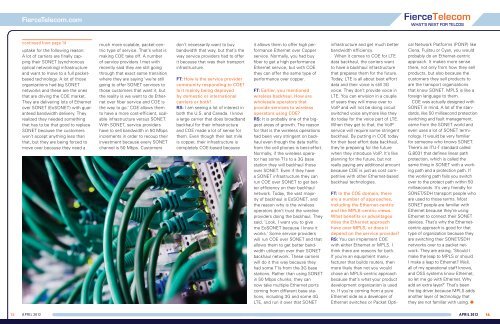Connection Oriented Ethernet - InfoVista
Connection Oriented Ethernet - InfoVista
Connection Oriented Ethernet - InfoVista
You also want an ePaper? Increase the reach of your titles
YUMPU automatically turns print PDFs into web optimized ePapers that Google loves.
FierceTelecom.com<br />
continued from page 14<br />
uptake for the following reason:<br />
A lot of carriers are finally capping<br />
their SONET (synchronous<br />
optical networking) infrastructure<br />
and want to move to a full packetbased<br />
technology. A lot of those<br />
organizations had big SONET<br />
networks and these are the ones<br />
that are driving the COE market.<br />
They are delivering lots of <strong>Ethernet</strong><br />
over SONET (EoSONET) with guaranteed<br />
bandwidth delivery. They<br />
realized they needed something<br />
that has to be that good to replace<br />
SONET because the customers<br />
won’t accept anything less than<br />
that, but they are being forced to<br />
move over because they need a<br />
much more scalable, packet-centric<br />
type of service. That’s what is<br />
making COE take off. A number<br />
of service providers I met with<br />
recently said they are still going<br />
through that exact same transition<br />
where they are saying ‘we’re still<br />
going to offer SONET services to<br />
those customers that want it, but<br />
the reality is we want to do <strong>Ethernet</strong><br />
over fiber service and COE is<br />
the way to go.’ COE allows them<br />
to have a more cost-efficient, scalable<br />
infrastructure versus SONET.<br />
With SONET, service providers<br />
have to sell bandwidth in 50 Mbps<br />
increments in order to recoup their<br />
investment because every SONET<br />
channel is 50 Mbps. Customers<br />
don’t necessarily want to buy<br />
bandwidth that way, but that’s the<br />
way service providers had to offer<br />
it because that was their transport<br />
infrastructure.<br />
FT: How is the service provider<br />
community responding to COE?<br />
Is it mainly being deployed<br />
by domestic or international<br />
carriers or both?<br />
rS: I am seeing a lot of interest in<br />
both the U.S. and Canada. I know<br />
a large carrier that does broadband<br />
backhaul for their infrastructure<br />
and COE made a lot of sense for<br />
them. Even though their last mile<br />
is copper, their infrastructure is<br />
completely COE-based because<br />
it allows them to offer high performance<br />
<strong>Ethernet</strong> over Copper<br />
service. Normally, you had buy<br />
fiber to get a high performance<br />
<strong>Ethernet</strong> service, but with COE<br />
they can offer the same type of<br />
performance over copper.<br />
FT: Earlier, you mentioned<br />
wireless backhaul. How are<br />
wholesale operators that<br />
provide services to wireless<br />
operators using COE?<br />
rS: It is probably one of the biggest<br />
areas of growth. The reason<br />
for that is the wireless operations<br />
had been very stringent on backhaul<br />
even though the data traffic<br />
from the cell phones is best-effort.<br />
Normally, if the wireless operator<br />
has some T1s to a 3G base<br />
station they will backhaul those<br />
over SONET. Even if they have<br />
a SONET infrastructure they can<br />
run COE over SONET to get better<br />
efficiency on their backhaul<br />
network. Today, the vast majority<br />
of backhaul is EoSONET, and<br />
the reason why is the wireless<br />
operators don’t trust the wireline<br />
providers doing the backhaul. They<br />
said, ‘Look, I want you to give<br />
me EoSONET because I know it<br />
works.’ Some service providers<br />
will run COE over SONET and that<br />
allows them to get better bandwidth<br />
utilization over their SONET<br />
backhaul network. These carriers<br />
will do it this way because they<br />
had some T1s from the 3G base<br />
stations. Rather than using SONET<br />
in 50 Mbps chunks, they can<br />
now take multiple <strong>Ethernet</strong> ports<br />
coming from different base stations,<br />
including 3G and some 4G<br />
LTE, and run it over that SONET<br />
infrastructure and get much better<br />
bandwidth efficiency.<br />
When it comes to COE for LTE<br />
data backhaul, the carriers want<br />
to have a backhaul infrastructure<br />
that prepares them for the future.<br />
Today, LTE is all about best effort<br />
data and their voice is still 3G<br />
voice. They don’t provide voice in<br />
LTE. You can envision in a couple<br />
of years they will move over to<br />
VoIP and will not be doing circuit<br />
switched voice anymore like they<br />
do today for the voice part of LTE.<br />
When they get to that, the VoIP<br />
service will require some stringent<br />
backhaul. By putting in COE today<br />
for their best effort data backhaul,<br />
they’re preparing for the future<br />
when they introduce VoIP. It’s like<br />
planning for the future, but not<br />
really paying any additional amount<br />
because COE is just as cost competitive<br />
with other <strong>Ethernet</strong>-based<br />
backhaul technologies.<br />
FT: In the COE domain, there<br />
are a number of approaches,<br />
including the <strong>Ethernet</strong>-centric<br />
and the MPLS-centric views.<br />
What benefits or advantages<br />
does the <strong>Ethernet</strong> approach<br />
have over MPLS, or does it<br />
depend on the service provider?<br />
rS: You can implement COE<br />
with either <strong>Ethernet</strong> or MPLS. I<br />
think there are reasons for both.<br />
If you’re an equipment manufacturer<br />
that builds routers, then<br />
more likely than not you would<br />
chose an MPLS-centric approach<br />
because that’s what your product<br />
development organization is used<br />
to. If you’re coming from a pure<br />
<strong>Ethernet</strong> side as a developer of<br />
<strong>Ethernet</strong> switches or Packet Opti-<br />
cal Network Platforms (PONP) like<br />
Ciena, Fujitsu or Cyan, you would<br />
probably do an <strong>Ethernet</strong>-centric<br />
approach. It makes more sense<br />
there, not only from how they sell<br />
products, but also because the<br />
customers they sell products to<br />
are the transport organizations<br />
that know SONET. MPLS is like a<br />
foreign language to them.<br />
COE was actually designed with<br />
SONET in mind. A lot of the standards,<br />
like 50 millisecond protection<br />
switching and fault management,<br />
came from the SONET world and<br />
even uses a lot of SONET terminology.<br />
It would be very familiar<br />
for someone who knows SONET.<br />
There’s an ITU-T standard called<br />
G.8031 that defines linear path<br />
protection, which is called the<br />
same thing in SONET with a working<br />
path and a protection path. If<br />
the working path fails you switch<br />
over to the protect path within 50<br />
milliseconds. It’s very friendly for<br />
SONET/SDH transport people who<br />
are used to those terms. Most<br />
SONET people are familiar with<br />
<strong>Ethernet</strong> because they’re using<br />
<strong>Ethernet</strong> to connect their SONET<br />
devices. That’s why the <strong>Ethernet</strong>centric<br />
approach is good for that<br />
type of organization because they<br />
are switching their SONET/SDH<br />
networks over to a packet network.<br />
They are asking, ‘Should I<br />
make the leap to MPLS or should<br />
I make a leap to <strong>Ethernet</strong>? Well,<br />
all of my operational staff knows,<br />
and OSS systems know <strong>Ethernet</strong>,<br />
so let me go with <strong>Ethernet</strong>. Why<br />
add an extra layer?’ That’s been<br />
the big driver because MPLS adds<br />
another layer of technology that<br />
they are not familiar with using. l<br />
15 April 2012 April 2012<br />
16
















